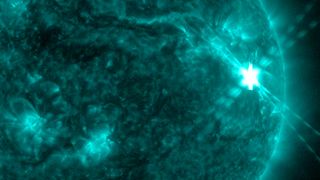The sun just gave us a reminder of its immense might.
Our star unleashed an X-class solar flare today (Dec. 14), blasting out an immense pulse of high-energy radiation that was captured on video by NASA's Solar Dynamics Observatory spacecraft. (Solar physicists classify strong flares into three categories, with C being the weakest, M the middling group and X the most potent.)
The outburst, which occurred at 12:02 p.m. EST (1702 GMT), registered as an X2.8, making it the most powerful solar flare since September 2017, according to SpaceWeather.com.
Related: Space weather: What is it and how is it predicted?

Powerful flares are often accompanied by coronal mass ejections (CMEs), which send huge clouds of solar plasma rocketing into space at millions of miles per hour.
It appears that a CME was indeed associated with this flare, likely "with an Earth-directed component," SpaceWeather wrote. "The US Air Force is reporting a Type II solar radio burst, which typically comes from the leading edge of a CME. Based on the drift rate of the radio burst, the emerging CME's velocity could exceed 2,100 km/s (4.7 million mph)."
CMEs that hit Earth can spawn geomagnetic storms, which can disrupt power grids and other infrastructure. Such storms can also supercharge the auroras, making these celestial light shows more intense and visible over greater areas.
Get the Space.com Newsletter
Breaking space news, the latest updates on rocket launches, skywatching events and more!
Earth's atmosphere prevents solar flares' harmful radiation from reaching the ground. But that radiation can still affect our lives — for example, by affecting the signals sent by GPS and communications satellites and causing radio blackouts.
Indeed, today's flare "caused a deep shortwave radio blackout over the Americas," SpaceWeather.com wrote.
We could see more solar action soon, for the sun is getting more and more active these days.
Solar activity waxes and wanes on an 11-year cycle. The U.S. National Oceanic and Atmospheric Administration predicts that the current Solar Cycle 25 will peak between January and October of next year.
Join our Space Forums to keep talking space on the latest missions, night sky and more! And if you have a news tip, correction or comment, let us know at: community@space.com.

Michael Wall is a Senior Space Writer with Space.com and joined the team in 2010. He primarily covers exoplanets, spaceflight and military space, but has been known to dabble in the space art beat. His book about the search for alien life, "Out There," was published on Nov. 13, 2018. Before becoming a science writer, Michael worked as a herpetologist and wildlife biologist. He has a Ph.D. in evolutionary biology from the University of Sydney, Australia, a bachelor's degree from the University of Arizona, and a graduate certificate in science writing from the University of California, Santa Cruz. To find out what his latest project is, you can follow Michael on Twitter.